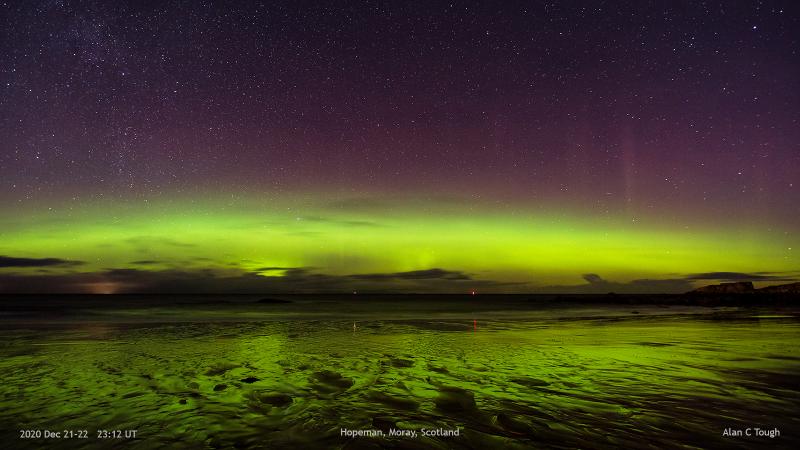Auroral & noctilucent cloud activity 2020 November I – December 31
2021 February 2

With no coronal mass ejections and sunspot numbers in double figures or at zero, there are only six aurora sightings in this report. The Sun is at minimum but is trying to lift out, and there have been several coronal holes.
Aurora
There was one G1-class storm and two sightings in November. Both observations were on Nov 21/22, by Denis Buczynski from Tarbatness and Alan Tough from Elgin.
There were no G-class storms and four sightings in December, all occurring on Dec 21/22. I saw it from Glenbarry, Denis Buczynski saw it from Tarbatness, Alan Tough did so from Hopeman and Rhona Fraser saw it from just outside Inverness.
Noctilucent cloud
I was expecting Antarctic noctilucent clouds (NLCs) to appear on the satellite imagery some time in mid-November. However, they did not appear until Dec 8 and then did so sporadically and in very small numbers; it was only towards the end of December that they began to increase in size. On Dec 8 I asked the British Antarctic Survey meteorologist and past Comet Section Director Jonathan Shanklin about it and his reply was as follows.
‘My guess would be that the lack of southern hemisphere NLC would be linked to the unusual stability of the southern polar vortex this year. Temperatures in the stratosphere are well below average, which will be linked to fewer upward-propagating waves. There isn’t much sign of the vortex going away in the next ten days, so it may be a very late NLC season. It does however look like breakup might take place before the solstice.
‘The circulation in the northern hemisphere is very different, as the current position of the jet stream shows. That said, the overall vortex is moderately stable at the moment, hence the likely formation of polar stratospheric clouds. I doubt the northern vortex would ever last long enough to coincide with the NLC season, although this year (2020) it lasted into mid-May – the latest ever. It was clearly the case that the majority of NLC reports didn’t start until after the breakdown of the vortex in May. So if my theory is right, then expect southern NLC to start round about the solstice.’
Prof Cora Randall, who runs the Cloud Imaging and Particle Size (CIPS) experiment on the NASA Aeronomy of Ice in the Mesosphere (AIM) satellite mission, came up with a similar explanation.
What happens in May in the northern hemisphere may be unrelated, as the geography is very different (land surrounded by sea, as opposed to sea surrounded by land), but we will wait and see.
There is a webcam operated by the Shetland tourist board (bit.ly/3iyToXq) which looks north and, if there is no cloud, will give a good view of any aurora or NLC. They have also added another camera further north, specifically for the aurora (bit.ly/3nW0fuX).
I would like to thank all the observers who have contributed, and I ask you to keep sending in those reports to sandra-b@hotmail.co.uk.
Happy New Year and good hunting!
Sandra Brantingham, Director, Aurora & Noctilucent Cloud Section
| The British Astronomical Association supports amateur astronomers around the UK and the rest of the world. Find out more about the BAA or join us. |
